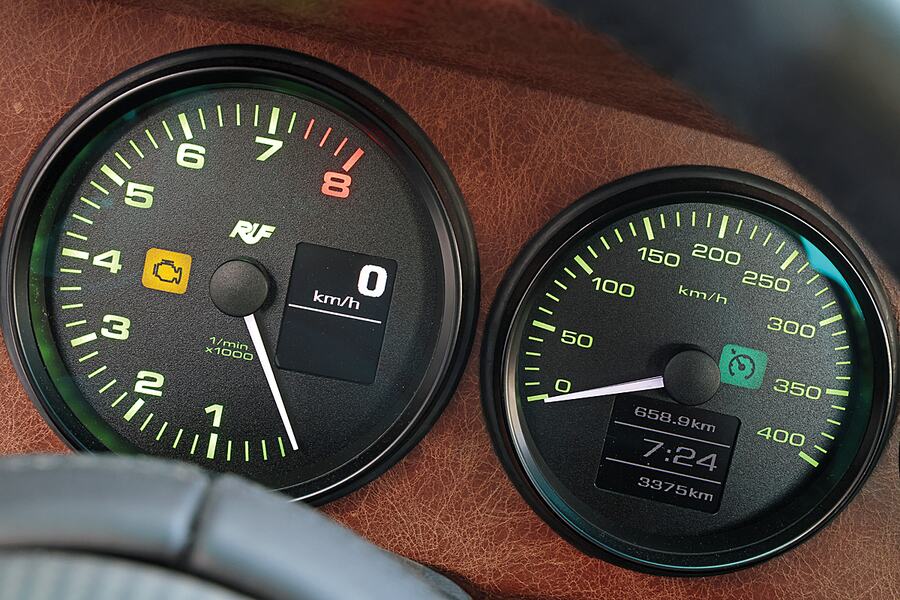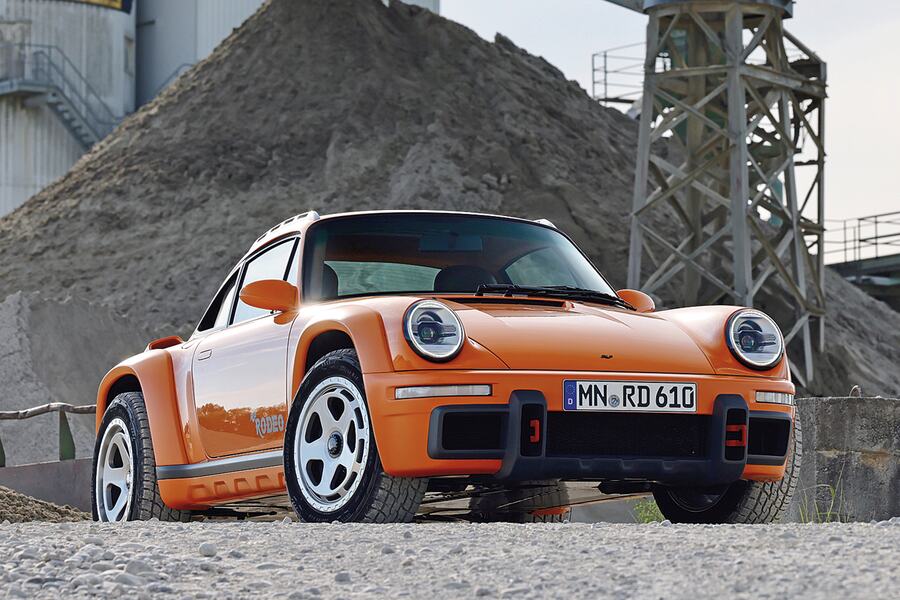Knowing what to expect from a car you’ve never driven often depends on past experience with its predecessors. But when a specialist manufacturer like Ruf builds something as singular as the Rodeo, all bets are off.
At a more mainstream level, Porsche has explored this terrain with the 992.1-generation 911 Dakar, and Marc Philipp Gemballa is delivering 40 examples of his Marsien supercar—an off-road machine powered by a Ruf-tuned 992.1-gen 911 Turbo S flat-six engine.
However, the Ruf Rodeo we see here is something quite different from those other on-road/off-road 911s that conceptually take their cue from Porsche’s 959 super/rally car of the mid-1980s.

The seed of the Rodeo idea was planted in late 2019 when Alois and Estonia Ruf first floated the concept of a Ruf model with true off-road capability. They saw growing enthusiasm for a 911 with raised ride height and tougher styling that was also usable as a daily driver.
“We started work in the fall of 2019, and the non-running concept car was ready in time for the 2020 Geneva Auto Salon,” Alois explained. “We finished the show car along with the bespoke hardwood diorama it was to be presented on, and everything was ready to go when COVID-19 hit the world.”
Undeterred by Geneva’s cancellation due to the pandemic, Ruf produced a video presentation that served as a virtual launch for customers and enthusiasts. Following much positive feedback from existing and potential clients, they decided to build the working prototype presented at Monterey Car Week in 2024.

An even larger enthusiastic response further validated the idea of a limited production run. Since the concept was well received by potential customers, it was important to retain a similar look and feel in the production version.
“The design evolved over about six months with Estonia, Aloisa, and I working through about seven or eight possible variations with our design team,” said Alois. “We also showed the computer-generated images to a handful of long-time Ruf customers for their reactions and comments. The final iteration of the Rodeo design was decided by our family and a handful of our customer inner circle.”
The pre-production Rodeo is a tough and eye-catching machine, and in this bright Signal Orange hue, you would have to be as blind as a bat to miss it! The big wheel arches bonded to the carbon-fiber bodywork cover enormous wheels and tires, creating a visual gravitas that makes most supercars look ordinary. In typical Ruf fashion, the ram air intakes for the intercoolers are mounted in-board above the rear wheel arches. This also helps to keep muddy water out when crossing shallow streams.

The bespoke rear exhaust silencer sends the spent gases to four stacked and squared-off exhaust tips in the rear bumper over-riders. For those familiar with Porsche’s design history, this is a nod to the 356 Carrera 2 and 356 SC/GT models, whose exhaust pipes exited through the rear bumper. The ’70s-era duck tail spoiler completes the classic 911 look and provides adequate lift reduction for the real-world speed range of this car.
Work on this pre-production Rodeo began in February 2024. The structure is a variation of the 964-style carbon-fiber body and monocoque with front and rear steel space frames as used on the Ruf CTR Anniversary and SCR models. This creates a very light and stiff structure with a torsional rigidity number of 26,000 Nm/degree of twist. For perspective, that level of rigidity is identical to the stiffness of the Porsche Carrera GT supercar.
Like its low-slung siblings, the Rodeo uses double wishbone suspension at all four corners, with race-style pushrods activating longitudinally mounted coilover shock absorbers on a 1:4 ratio. Apart from the specific spring and damper rates calibrated to the Rodeo’s off-road capability, the suspension is unchanged, with the exception of the bespoke wheel carriers, which provide a static ride height of 9.0 inches versus 5.1 inches for the SCR and CTR Anniversary.

While the Rodeo shares its basic suspension with the rear-drive-only SCR and Anniversary, a bespoke Ruf all-wheel-drive (AWD) system was developed alongside the suspension. For maximum fun, the software controlling the non-adjustable differentials on other AWD Ruf models has been customized to allow driver control of the front-to-rear torque split. Ruf installed a dashboard knob that lets the driver dial front axle torque down to just five percent—ideal for controllable oversteer and rally-style slides.
We noticed that the Rodeo test car was equipped with 350 mm (13.8 in.) diameter ceramic discs all around with six-pot front and four-pot rear calipers. We queried Alois on this since off-road vehicles normally have steel brakes to avoid expensive damage should a stone become trapped between the disc and caliper.
“We give the customer the option,” he replied. “If they intend to drive the car off-road, then we would always recommend steel brakes, but on this pre-production car, we decided to use ceramics for the best braking performance and pedal feel.”

The distinctive 8.5J x 18-inch center-lock forged alloy wheels are made by OZ Racing and shod with custom-made 235/55R-18 Goodyear rubber wearing the ‘Ruf Rodeo’ logo on their sidewalls. These five-spoke wheels have extra cooling slots on their circumference and reinforce the purposeful demeanor of this car.
Porsche’s 911 Dakar is powered by the 3.0-liter twin-turbo Carrera S engine with 473 horsepower and 420 lb-ft of torque to push 3,552 pounds. The current factory 911 Turbo S weighs an even heftier 3,649 pounds, and its 3.7-liter twin-turbo flat-six makes 640 hp and 590 lb-ft of torque.
For the Rodeo, Ruf changes the equation by using the 997 Turbo-based 3.6-liter twin-turbo engine from their CTR Anniversary tuned to 610 hp and 516 lb-ft of torque. This engine mates perfectly with the manual six-speed gearbox, developed for Ruf by ZF and also used in the CTR and SCR. In this application the gearing is also lowered to improve low-speed acceleration and response. Since high-speed performance is irrelevant here with the increased ground clearance and speed-restricted off-road tires, top speed is electronically limited to 155 mph.

Thanks to its lightweight race car construction methods, the Rodeo tips the scales at a modest 2,976 pounds, or a whopping 673 pounds lighter than the more powerful factory 992.1 Turbo S, so the power-to-weight ratio remains roughly similar.
The most significant mechanical change that affects the way the Rodeo drives is the six-speed manual gearbox with a limited-slip differential and dual-mass flywheel that gives the driver a much greater feeling of control than with the PDK-only Turbo S. Most onlookers won’t even notice the Rodeo has a manual gearbox—at least not until they stop gawking at the wild, colorful interior and spot the stubby gear lever.
This themed interior trim was all Estonia Ruf’s work. She and Alois met many years ago in Texas, where she had studied and was living at the time. So, it is no surprise that the chosen fabric has a distinctive Native American look to it that evokes images of the Wild West.

Considering the power and torque that has to be transmitted reliably, it is no surprise that the Rodeo’s clutch is on the heavy side. Once on the move, however, it feels normally weighted and positive with each upshift, with the low-end punch of the twin-turbo engine making for free and easy driving. The taller ride height is actually discernible from the exquisitely trimmed bucket seats, the all-around view being better than that from a standard 911. The perceived headlight performance at night should also benefit as well.
While the AWD system provides reassuring grip and handling off-road, the big knobby treaded rubber is never going to be as grippy as low-profile tires on the tarmac. While I instinctively realized this, it was still a surprise when I dropped the hammer on the road and found the massive torque hit and lower gearing, breaking the grip of all four tires momentarily as the electronics took a split second to hook things up and restore iron-fisted control.
Once order had been regained, the Rodeo shot off down the road, with each upshift simply turning the deep well of power and torque into rapid forward motion. The knowledge of reduced mechanical grip made me more hesitant than usual to aim the Rodeo at a familiar bend with the pace I would adopt with the SCR or CTR Anniversary. Nonetheless, the Rodeo’s progress across familiar local country roads was still remarkably rapid, and the ceramic brakes were put to good use, scrubbing off speed before bends.

The Ruf family affair is what draws
loyal customers to make the pilgrimage to their Pfaffenhausen, Germany, base. Commissioning a Ruf car onto which you stamp your own individuality is like automotive haute couture tailoring. And as with a Savile Row suit, every last stitch represents something unique, proudly stamped with your own personal identity.
From its potent twin-turbo powerplant to the satisfying precision of its six-speed manual and the surreal experience of carving through the countryside in something that looks fit for a desert showdown, the Rodeo is no mere novelty. It is a well-engineered, wildly charismatic machine built for those who want a 911 that can wrestle gravel and grab attention in equal measure. This isn’t just Ruf thinking outside the box, it’s Ruf building a whole new sandbox to play in.







